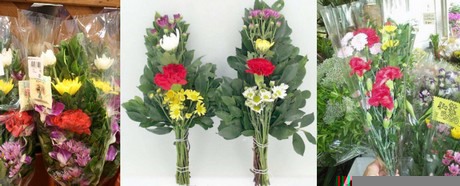Together with the Flowering Japan Council, he tries to increase the flower consumption by linking flowers to festivities that are popular, and in particular among the younger generation, at the moment, like Valentine's Day.

Main flower events in Japan
Japan knows six main flower events; Ohigan (around March 20), Mother’s day (second Sunday of May), Shin(New)-Bon (July 15), Kyuu(old)-Bon (August 15), Ohigan (around September 23), Christmas & End year (from Mid-December). Four out of the six events, Ohigan and Bon, are traditional Buddhism festivals. "Ohigan is on the day of equinox, so we have 2 ohigans (vernal and autumnal equinox). During the Ohigan week, Japanese people will visit their ancestor tombs to pray for the happiness of family and ancestors spirits by contributing Buddhism bouquets to tombs and family altar at home." Another important Buddhism festival that is celebrated with flowers is Bon. "It is the day when the Japanese believe the old ancestor spirits will return home and they pray for the happiness of the family and ancestor spirits by visiting family tombs with Buddhism flowers and family get-together decorating the family altar at home." Depending on the regions, there are 2 Bons.
Buddhism bouquets
Buddhism bouquets consists mainly of Chrysanthemum, micro chrysanthemum, standard carnation and spray carnation covered with Sakaki green leaves (Cleyer japonica or Eurya japonica), where they add the seasonal tastes with lily, gentiana, antirrhinum, statice, dendorobium, iris, liatris, lisianthus, physalis alkekengi, hypericum etc.

Imports
Japan is a large flower production country but in these 16 years, the flower production area reduced by 25%. Flower Import has reached 17% in value and 25% by volume. According to Kaishita, due to Buddhism as the main religion, among the annual flower consumption of 6 billion stems, 33% is chrysanthemum, 10% as carnation and 8% as rose. And most of these flowers are being imported. "52% of the spray chrysanthemums are imported, with the majority coming from Malaysia. 56% of the carnations are imported, with the majority coming from Colombia and 18% of the roses are imported, with the majority coming from Kenya."

Decrease consumption
However, the demand for Buddhism bouquets is expected to decrease gradually in the future. "Only 34% of the population believes in Buddhism nowadays", says Kaishita. "One third of the homes in Japan have a Buddhist family altar. Usually twice a month, people put Buddhist bouquets in this altar. However, due to the increase in amount of non-religious young peoples over the last years. This tradition of putting flowers in the altar also declined. Only those over 60 years old are still offering Buddhism bouquets to home altars."
And in general, the retail consumption of cut flowers, garden plants and materials in Japan faced a decrease of 17% from 10 billion euros in 1998, to 8.3 billion euros in 2012. Especially the consumption of flowers and plants of people under the age of 50 years is low compared to people above this age," explains Kaishita. According to him, 49 percent (in 2009) of the total Japanese population, and in particular the younger generation does not have a religion, and this could be part of the cause for this decrease."

Valentine's Day
So, Flowering Japan Council, which is established for promoting flower consumption, tries to link flowers to festivities that are more popular among the younger generation at the moment, like Valentine's Day. "'Flower Valentine' promotion started in 2011 to increase males to present females with flowers and plants instead of Japanese traditional way of females present males with chocolates. It shows the increase trend of flower consumption even for the young generations."
For more information
Japan Floral Marketing Association
Chrysal
Nobuya Kaishita
Email: [email protected]
mpsjapan-blog.jugem.jp
